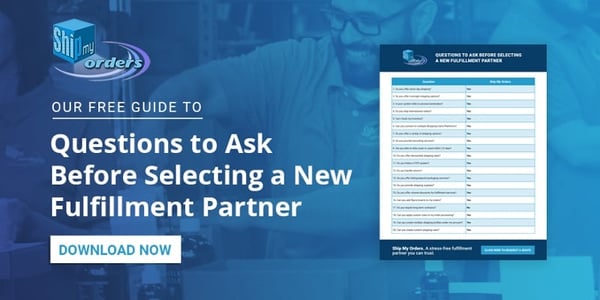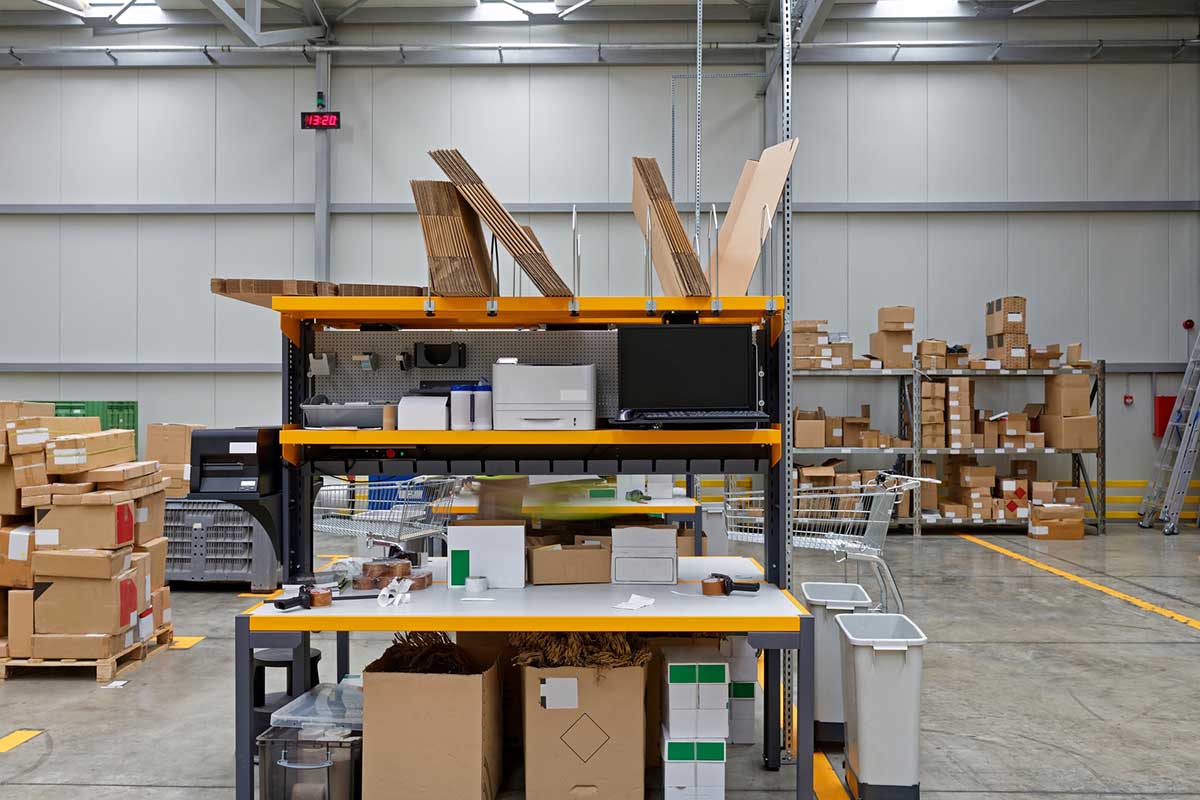
Can your eCommerce shipping and delivery strategy meet the demands of your customers? Studies show that 98.1% of shoppers consider the quality of their delivery when developing brand loyalty, while 84% won’t shop with a business again if they have a poor last-mile experience. Online businesses can quickly discover that their initial shipping and delivery strategy and capabilities can’t fulfill the needs of their customers. If you need to scale your shipping and fulfillment process, can you rely on your existing inventory system and infrastructure, or do you need to outsource?
The Importance of Shipping & Delivery in eCommerce
Shipping and delivery have emerged as one of the most critical components for an eCommerce business strategy. With major companies offering even same-day delivery, you need to be able to ship your goods to customers quickly and cheaply. Shipping and delivery costs can quickly eat away at your margins if you don’t carefully track them. Sudden price or rate changes can make some of your delivery terms unprofitable, meaning you need to have the flexibility to adapt to rapid changes.
A bad shipping and delivery process can also cost you sales. Customers who make it through to checkout can still dump their cart if they dislike your shipping terms. According to the Baymard Institute, an e-commerce research company, the average shopping cart abandonment rate across 41 cart abandonment studies was 69.57%. On the other hand, an inadequate shipping and delivery strategy can form bottlenecks that hinder the growth of your business, causing you to scramble to build or find capacity to meet new demand.
However, your shipping and delivery processes also present opportunities to build your brand and customer loyalty. Many companies have made the process of unboxing an experience to delight customers, with unique packaging, special messages, or other thoughtful additions. This also presents opportunities to reach new customers who can see an unboxing video online or who want to know the story behind the packaging. Choosing the right shipping process is vital to your company’s growth and its ability to satisfy and retain customers.
What Are the Best Shipping Options for eCommerce & Online Stores?
By investing the time and effort to plan out a shipping strategy, your business can meet the demands of your customers while minimizing future growing pains.
Calculating (and Reducing) Shipping Costs
Shipping costs may seem trivial when your firm is new or relatively small, but they can quickly add up as your business starts to scale. Developing a systematic understanding of these costs early on can help you avoid those growing pains. You’ll know what to expect as your shipping costs grow and will be in a better position to take steps to reduce them. Three of the main shipping costs your business will face are the following:
- The size and weight of a package: Heavier, bulkier items typically cost more to ship than smaller ones.
- The destination of a package: Shipping costs will generally increase the further your package has to travel. However, the way this is calculated will vary from carrier to carrier.
- The type of carrier or shipping service you use to deliver the package: Different carriers have their own specialties, service areas, and prices. You may switch between many different ones to get the best prices.
Once you learn about the shipping expenses your business faces, you can gain key insights that can help you to lower those costs. Some of the strategies you may want to adopt in your business are the following:
- Standardizing the size and weight of your goods to make shipping costs predictable.
- Choosing packaging that delivers the most value to customers.
- Periodically reviewing your carrier’s shipping rates.
- Moving your goods closer to your target market, such as by contracting with a warehouse or fulfillment center.
In addition to lowering your shipping costs, these insights can have the knock-on effect of improving your business’s overall operations and efficiency. You may find that you can streamline your production processes and save on production costs. You can also deliver a more consistent customer experience as you further improve your production methods.
Types of Shipping Methods and Providers
Some types of shipping carriers are better at reaching some markets than others, making it vital that you choose ones which can best serve your customers. Some also offer services that you may not need, which means you might work with multiple carriers to obtain the particular services you want. Carriers typically fall into one or more of the following categories:
International Carriers
Shipping goods internationally can be a time-consuming and expensive process for companies that don’t know how to navigate this field. International carriers have streamlined methods for taking your goods through customs and arranging for shipping to the final destination. They can also inform you of anything you may have to do on your own end so you avoid red tape and delays in shipping. Some international carriers don’t handle shipping themselves but function as freight-forwarders, or liaisons between your business and shipping companies.
International carriers specialize in shipping goods between international borders, so companies that are operating domestically likely don’t need to work with one. International carriers also tend to handle large numbers of clients, which can be a problem if you want to work closely with your logistics company and customize your delivery process. Working with an international carrier can also be expensive, pricing some businesses out of their services.
National Carriers
National carriers offer coverage throughout the United States and typically have a sophisticated network of warehouses, distribution centers, and shippers at their disposal. They can offer exceptionally low prices given the volume of orders they process. They also have a technological edge over other carriers, which allows them to continuously optimize routes for efficiency. Working with a national carrier can also reduce the number of relationships you have with logistics providers.
While national carriers are useful for shipping your goods across long distances, they may be outpaced by smaller carriers over the “last mile.” It’s also atypical for national carriers to offer personalized service, which may be a sticking point depending on what level of control you want to have over your inventory and the delivery process. National carriers offer less flexibility than local or regional carriers and have few to no opportunities for negotiation. They may also have limited service to remote areas.
Freight Forwarding Solutions
Freight forwarders, also known as freight brokers, can be simply described as companies that organize the shipping of your goods. They will typically have existing relationships with a wide range of other logistics companies that will handle the actual physical transportation of your goods. Freight forwarders are critical partners for businesses engaged in imports or exports, as they can handle all of the red tape to get your goods quickly across international borders. They offer a vast array of services, including the following:
- Book space for your goods on ships
- Negotiate with shippers for the best price
- Negotiate freight consolidation
- Obtain insurance for your goods
- Obtain customs
- Prepare documents
A freight forwarding solution is practically a necessity if you’re moving your goods across international borders. However, these companies don’t handle the physical shipment of your goods, which means you may need to still partner with another logistics company.
Third Party Logistics (3PL) Companies
Many companies are turning to third party logistics (3PL) companies to handle their warehousing, fulfillment, and distribution needs. Companies that partner with 3PLs can devote the vast majority of their resources to their core services. A 3PL can be especially useful to a new or growing company that either doesn’t have robust logistics capabilities or which can’t devote resources to grow them. 3PLs vary widely in size and the services they offer, but here are some that may fall within the scope of a provider:
- Warehousing and short-term storage
- Insurance
- Kitting
- Pick, pack, and ship services
- Inventory management
- Guaranteed delivery levels
- Customer service
Companies need to carefully choose their 3PL partners because they effectively serve as the customer-facing side of their operations. One missed delivery or damaged package can sink your reputation, so you need to work with a partner that has a proven track record of delivering goods on-time to the markets you service. In addition, some 3PLs are lack financial stability and may suddenly close, leaving your customers and inventory in limbo. When choosing a 3PL, check their reviews online and find out how long they have been in business to see if they have a long-term track record for success.

eCommerce Shipping Strategies
Customers today don’t want to wait for their purchase to arrive on their doorstep, and supply chains have adapted to the demand for speed. Companies now have a wide range of rapid shipping strategies to choose from. Your shipping strategy will depend on what your customers expect as well as the type of products you offer, your shipping budget, and what your margins can support. Depending on your customer base, you may use some or all of the following shipping strategies:
Same-Day Delivery
The gold standard for fast shipping is same-day delivery service, which is fast becoming the new norm, especially for perishable goods. Same-day delivery means customers get their orders the day they make them. Same-day delivery can eliminate backlogs while boosting productivity, as goods have to reach their destinations the day an order is placed. Same-day delivery can also be used to drive sales, as it can be reserved as a special bonus for particular items or during promotions.
In order to make same-day delivery possible, you’ll need an extensive network of fulfillment and distribution centers at your disposal. It’s possible to obtain this via partnerships with logistics companies, but it can become difficult and expensive to manage, as you may have to work with numerous different partners. You’ll also need to keep a large stock of inventory on-hand to meet demand as it happens. Same-day delivery is less efficient than other forms of shipping too, as you’ll have to ship the day an order comes in and can miss out on cheaper routes and economies of scale.
Overnight Shipping
With overnight shipping, packages are shipped out the day an order is placed and reach their destination the next day. Overnight shipping is expensive, but the good news is that customers are willing to pay for it. According to a study by MarketingProfs, 60% of buyers were willing to pay significantly more to cover the cost of overnight shipping. While it can be a challenge to fulfill every order overnight, it’s very easy to do so in some of the biggest markets in the US.
Overnight shipping isn’t without risks, and is subject to disruption, especially during inclement weather. Cut-off times for overnight shipping vary between carriers but typically end at around 5PM the day an order is to be shipped. In order to execute overnight shipping, you’ll need a robust, and likely expensive, logistical infrastructure. Failure rates can also be higher for same-day delivery than other types given the pressures to fulfill orders.
Two-Day Delivery
With two-day delivery, a customer places an order and receive it in their home within two business days. The National Retail Foundation reports that 39% of consumers want free two-day shipping, with 29% of consumers having abandoned a purchase because it wasn’t available. Two-day shipping has become an industry standard, making it practically a necessity for businesses to compete with larger retailers. It can also reduce cart abandonment and improve customer loyalty, as they know what to expect when placing an order.
Two-day shipping can be difficult for startups and small-to-midsize businesses to handle on their own, especially if they are shipping cross-country. Adverse weather or other disruptions can cause delays, making it possible that a two-day guarantee isn’t met. Even larger companies can have trouble guaranteeing 2-day shipping to all locations in the US, so you might want to limit this option to certain zip codes. There’s much confusion among customers as to what two-day shipping actually entails, meaning this could be a source of frustration if your policies aren’t clear.
Expedited Shipping
Expedited shipping refers to the practice of prioritizing the delivery of certain packages over others, typically within 1-2 days after an order is placed. Expedited shipping can boost customer satisfaction, as customers get their goods fast and at a guaranteed time. It also offers greater transparency to shipping companies, as they can easily monitor the progress of a package toward its destination. Expedited shipping also offers greater security than other forms of shipping, as packages generally make fewer stops and have fewer chances to be damaged or stolen.
Expedited shipping offers numerous benefits, but it can be very difficult to execute, especially if you’re working with several different logistics companies. Expedited shipping is also typically very expensive and may even entail risks to drivers, especially if they are working in remote locations. Shipping delays can cause additional displeasure among your customers, as they likely paid extra for expedited shipping. Furthermore, expedited shipping can cause inefficiencies within your own business, as you or your employees must coordinate shipments or handle customer complaints.
Free Shipping
Companies that offer free shipping to their customers absorb shipping costs for them. According to 2018 study by Arvato, a global services firm, 83% of US shoppers said free shipping was the most important factor when making an online purchase, while 23% abandoned carts due to high shipping costs. Customers love free shipping, and as customer experience is becoming the decisive factor in sales, offering free shipping could be well worth the price for your company. Free shipping can also reduce cart abandonment while helping your business compete with bigger companies.
Free shipping can help to drive sales, but your company might have to bear that cost if you don’t want to raise prices. Free shipping also can lead to more returns as customers make more impulsive purchases. You might also have to increase prices for your products, which can reduce your overall number of sales. If you can’t afford to offer free shipping on all of your products, you might reserve it for some high-ticket items or when running a promotion.
Related: 11 Different Types of Shipping Methods
eCommerce Shipping Best Practices
You can make your business more profitable and adaptable to changes by implementing key eCommerce shipping best practices, including the following:
Reduce Costs
Shipping prices and the way they are calculated will change over time, providing more opportunities for you to reduce your costs. More companies are offering real-time technology that allows you to monitor your shipping costs as they happen, so consider taking advantage of them. Review how you pick, pack, and sort packages to know if this process needs to be further optimized or outsourced. Consider bringing parts of your supply chain in-house or eliminating them if possible to streamline your operations and to reduce production costs.
Convert More Visitors
How well can your site convert visitors into customers? Consider offering a variety of shipping options to match the different personas that your business services. You may also want to A/B test and heatmap your site to offer the optimal shipping options and layout for your visitors. Some of your customers may prefer one form of shipping over another, and giving them options can help to reduce cart abandonment.
Increase Order Value
Many online companies offer free or reduced shipping if their customers purchase a certain dollar amount of goods. Find out what you want your average cart to be and consider offering free or reduced shipping for customers who buy that amount or more. You might also offer this for specific items you want to move, such as for high-ticket items. Consider flash sales or holiday sales with this offer to further boost your average order value.
Grow Your Market
Customers have all the power today, so you’ll need to work with them and meet them where they are. Consider offering free or reduced shipping when entering a new market to develop a market for your goods. For locations closer to urban areas, you may want to offer same-day delivery or in-store pickup, if possible. Be sure to promote these offers online where your customers will see them, such as your website, social media, and search engines.
A successful shipping and delivery strategy adapts to your customer’s needs and changing conditions in your supply chain. There isn’t a one-size-fits-all strategy, so you’ll have to consider your demands and constraints when crafting one. You’ll also want to review your strategy at least every six months to make improvements that ensure your customers are getting the best prices and service possible. While you can attempt this process on your own, an experienced logistics company can provide you with the expertise and resources needed to optimize your shipping strategy.
Ship My Orders can help you achieve this by offering tailored solutions that fit your unique requirements. With our extensive experience and advanced logistics capabilities, we can streamline your shipping processes, reduce costs, and enhance your overall service quality. Let us be your partner in delivering exceptional customer experiences through a well-optimized shipping strategy. Reach out to us today.


-1.png)


